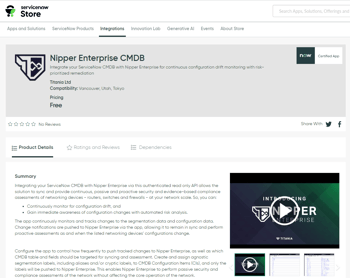As of this week, Nipper Enterprise becomes Nipper Resilience. This name change reflects a critical evolution: organizations are no longer focused solely on defending their networks—they're demanding technologies that strengthen network resilience, the foundation of business-critical, organizational resilience. The shift underscores a growing recognition that in today’s threat landscape, resilience isn’t a nice-to-have—it’s a strategic imperative.
At the heart of this evolution lies Network Exposure Management — a proactive, strategic approach that gives Security Operations Centers (SOCs), Network Operations Centers (NOCs), and Incident Response & Remediation teams the continuous visibility and control they need to protect what matters most: business-critical connectivity.
Why now?
Cyber threats aren’t just evolving—they’re accelerating. From once-in-a-generation state-sponsored targeting of critical national infrastructure to bring about societal collapse, to routine misconfigurations causing global outages that affect millions, the threats to today’s networks are intensifying in both scale and complexity. As critical systems grow more interconnected and regulation tightens, it’s no longer enough to patch vulnerabilities after the fact. Organizations must now anticipate, detect, and respond to exposure in real time—because when networks get breached, it shouldn’t put a stop to business if the right controls are in place.
To address this, government regulations like DORA and NIS 2 are no longer just mandating security hygiene—they're demanding true operational resilience. In response, forward-thinking organizations are increasing investment in proactive security strategies that go beyond traditional approaches.
Why? Because existing programs and tools often fall short:
- Critical services and data are not consistently identified, segmented on the network, or backed up— undermining organizational ability to identify attack exposure and compromise, and limiting disaster recovery and pre-deployment testing.
- Programs lack real-time visibility into network changes, industry-specific exposures, and the ability to remediate, respond and recover from business-critical risks.
- Endpoint-centric solutions can’t continuously enforce least-privilege access or prevent lateral movement across networks through adequate segmentation assurance.
- Tech stacks aren’t CMDB-centric, so fail to support pre-deployment testing, disruption root-cause analysis, or enable effective and efficient rollback and disaster recovery.
That’s why the shift from traditional vulnerability management to comprehensive Network Exposure Management that address the current limitations, is fast becoming mission-critical for CISOs and leadership teams focused on building resilient, future-ready organizations.
Because in today’s threat landscape, it’s not just about surviving disruption—it’s about withstanding, recovering, and continuing to deliver, even under pressure. This is what protects national security, customer trust, and economic prosperity.
On a mission to enable organizations through this shift, Titania solutions have been designed to add value at every step of the way to network readiness and resilience.
Built to scale with your resilience journey
Recognizing that every organization is at a different stage of its resilience journey, Nipper Resilience has been designed for flexible deployment and scale. Whether you are ready for continuous monitoring or prefer a scheduled assessment cadence—such as monthly or quarterly—Nipper Resilience ensures you analyze comprehensive, context-rich network data to build an in-depth understanding of your security posture, prioritize critical risks for remediation, and maintain visibility of configuration drift across the entire network. As organizations mature, they can seamlessly transition to continuous monitoring without needing to replace From Quarterly Assessments to Continuous Resilience:or reconfigure their solution.
The ultimate goal: Proactive Network Resilience
Organizations today are increasingly reliant on network infrastructure to maintain operations, safeguard customer trust, and deliver critical services. From data centers to cloud architectures, routers and switches and firewalls are the connective tissue of our digital world.
Yet as CISA Director Jen Easterly underlined in conversation with the Foundation for Defense of Democracies (FDD) Senior Director, these core systems are “the soft underbelly of critical infrastructure,” often overlooked and highly vulnerable to exploitation.
The threat is not theoretical. Advanced persistent threat actors—like Volt and Salt Typhoon—have demonstrated how devastating the impact can be when they exploit insecure network infrastructure devices. They lay dormant for months or years, “living off the land,” collecting intelligence, and striking for maximum damage.
To build resilience in this environment, organizations must:
- Detect and contain breaches in real time
- Understand exposure to sector-specific threats
- Minimize preventable disruptions
- Assure compliance with frameworks like DORA, NIS 2, Zero Trust, and CORA
- Build capability over time, from scheduled network assessments to full real-time exposure monitoring
And they must do this continuously—or as frequently as their operational maturity allows—not just when a threat is detected.
Beyond Vulnerability Management: The Rise of Network Exposure Management
Traditional vulnerability management focuses on software patching and fixing misconfigurations. But in today’s dynamic, distributed, and hybrid environments, that’s only part of the story. Configuration changes, software updates, and poor segmentation can all open doors to attackers — and in many cases, organizations do not have full visibility of their actual security posture between audits.
“Creating prioritized lists of security vulnerabilities isn’t enough… go beyond vulnerability management and build a continuous threat exposure management program.” — Gartner, “How to Grow Vulnerability Management into Exposure Management”
Network Exposure Management offers a broader, real-time view—tracking not only vulnerabilities but how your network’s configuration, segmentation, and access policies expose you to attack vectors specific to your industry.
And because Nipper Resilience supports both continuous and scheduled network posture assessments, organizations can implement exposure management at a pace that matches their operational readiness—while still delivering actionable insights to close critical gaps.
Nipper Resilience: Making Networks More Ready, Recoverable and Resilient
At the forefront of this proactive security movement is Titania. Trusted globally by elite cyber teams, Titania has evolved its value to SOC, NOC, Threat Hunting and Incident Response & Remediation teams by developing Nipper Resilience to:
- Monitor Every Change: Full Network Visibility - Establish configuration baselines and identify all changes—planned, unplanned, and unauthorized—to detect anomalies and potential Indicators of Compromise (IoCs).
- Contain Threats: Enforce Network Segmentation - Prevent attackers from moving laterally by hardening routers, switches, and firewalls at the macro segmentation levels.
- Prioritize Risk: Analyze Network Exposure to Real-World TTPs - Go beyond CVEs by aligning vulnerability prioritization with the specific Tactics, Techniques, and Procedures used by active threat actors in your industry, with real-time visibility of compromise.
- Ensure Continuity: Maintain Accurate CMDBs - Enable configuration as code, support disaster recovery, and automate detection and visibility of all configuration changes to facilitate rollback and rapid response.
- Demonstrate Compliance: Assess at Scale - Assess up to 250,000 devices daily for compliance with frameworks like NIST, CIS, DISA STIG, PCI DSS 4.0, and EU, US, and MEA network readiness and resilience mandates.
Whether you’re conducting scheduled quarterly exposure assessments today or advancing to real-time resilience monitoring, Nipper Resilience scales to meet your operational goals—and grows with you as your security posture matures.
Ready to make the shift?
Nipper Resilience gives your teams the visibility they need to:
- Track all network changes—planned or otherwise
- Identify exposure to targeted attack vectors
- Detect segmentation and least privilege violations
- Validate configurations pre- and post-deployment
- Quantify your network’s true readiness and resilience
Don’t wait for the next incident to exploit your vulnerabilities and disrupt operations. Make the shift to proactive Network Exposure Management today—and build the network resilience your business demands.
Take a Product Tour to see how we help organizations like yours stay secure, compliant, and operational.






